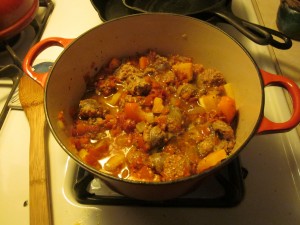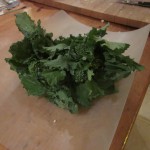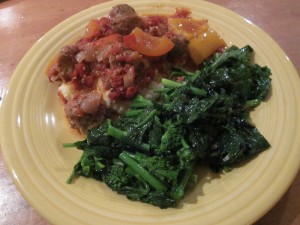It has been a long time since I have written a blog post – almost a year! This has been an incredible year; the most important part is that I have been working with many different clients with many different issues. Working with all of you has been a great source of joy and inspiration for me.
I sometimes get asked, if I could give people one piece of advice to improve their health and wellness, what would it be.
All other things being equal, the answer is: Be conscious of the food you eat – understand the ingredients; know how it is prepared; and “consciously” ask yourself, do I really want to eat this food?
This advice is hardly revolutionary. But, in today’s world, one could say it is largely counter-evolutionary.
In the last several decades, our society has evolved into a world where we are less concerned with what we eat, and more concerned with how long it takes to eat it. Grabbing a “quick bite” has become more important than eating good food. Starting in about the 1950’s, mass produced burgers, wrapped in Styrofoam or wax paper became acceptable, even desirable, sustenance if it meant getting somewhere on time, getting more work done or pleasing your kids, who wanted the toy of their favourite cartoon character that came with their burger.
Even home cooked meals joined the rat race and were put into overdrive. Ingredients like sugar, bleached white flour, white rice and the beloved sodium became the fuel that drove the engine and, for many meals, the microwave became the race track.
So, how did this become the road most traveled? There are probably a number of factors that deserve honorable mention. But, none is more significant than communications technology. To illustrate the impact this technology has played in both how and what we eat, I’ll tell you story about my husband’s first encounter with a Blackberry.
In 2001, his brother was in Toronto on business and invited him to drive into the city and meet him for dinner. They were eating at a trendy restaurant in the Queen West area. It was about 9:30 pm and they had just been served their main course. His brother’s Blackberry rang, either with an incoming call or email. He quickly looked at it and put it away. He then proceeded to wolf down his food before standing up and saying, “I’m going outside and deal with this.”
My husband said, “Hey, it’s quarter to 10 at night, they can’t expect you to just jump and get back to them. It is after hours, man, it is your time. You’re having dinner with your brother!”
His brother looked at him and with total seriousness, said, “When we were given these things we were told, if the office contacts you we expect you to reply 24/7.”
If the infiltration of communications technology into every waking moment of our day was not bad enough, it has been matched, gig for gig, by the equal proliferation of information technology, including news, entertainment and, most significantly, advertising.
We are all just so “busy.” Fast, mass produced and highly processed food helps us to get on with our “busyness.” And, all that advertising helps us know where to find it.
After many years of neglecting “what” we eat in favour of “how” we eat, something happened on the way through the drive thru. Somewhere along the line, we got fat. Between 1979 and 2004, obesity rates in Canada skyrocketed. In children between 12 and 17, the obesity rate tripled to just under 10%. For adults between 24 and 35, the rate more than doubled to over 20% and in seniors over 75, the rate also doubled to just about a quarter of all people. (Source: https://www.statcan.gc.ca/daily-quotidien/050706/dq050706a-eng.htm)
In the United States, where obesity is worse than in Canada, U.S. Surgeon General, Richard H. Carmonal, testified before Congress in 2003, saying:
“I welcome this chance to talk with you about a health crisis affecting every state, every city, every community, and every school across our great nation. The crisis is obesity. It’s the fastest-growing cause of disease and death in America. And it’s completely preventable. Nearly two out of every three Americans are overweight or obese. One out of every eight deaths in America is caused by an illness directly related to overweight and obesity.”
Dr. Carmonal went on to say that in the year 2000, obesity cost the U.S. economy $117 billion. By 2012, that number had grown to almost $200 billion, exceeding even smoking as the number one driver of rising health care costs. (Source: https://www.reuters.com/article/2012/04/30/us-obesity-idUSBRE83T0C820120430?feedType=RSS&feedName=domesticNews)
Dr. Carmonal fingered lack of physical activity and poor eating habits as the two key culprits “feeding” this growing crisis. He identified the key factors to overcoming the crisis as, more exercise, better nutrition and improved health literacy.
It is the third of these key factors, improved health literacy, which brings us back to the advice I gave earlier. Food literacy is a component of health literacy. Be conscious of what you eat. Read labels – understand the ingredients you are ingesting – know how your food is prepared and what that means for nutritional value. And, consciously ask yourself, do I really want to eat this food.
Now for the good news. The times they are a changing. With health costs soaring and the baby boom generation getting older and having to focus more on staying healthy, there is renewed interest in “what” we eat. The signs are all around us. For example, a growing percentage of customers going into drive thrus are ordering salads. Cafeterias in schools, hospitals and other institutions are improving the nutritional value of their menus, sometimes removing soda pop and high sugar foods. Terms like “whole foods,” “free range,” “Grain fed,” and “organic” are becoming more and more common in our food vocabulary (though they should not be accepted at face value).
There is some more good news. The human body is an incredible organism. Our bodies want us to succeed and to be healthy. They can, if properly treated, reverse a great deal of neglect and self-abuse. In other words, except in extreme cases, it is never too late to eat right and get healthy.
The purpose of this article is not to lay out a specific diet plan. There are many resources available that can do that. The purpose of this article is to drive home the point that you need to be conscious of what you eat. The food we choose to fuel our bodies is one of the most important and personal decisions that we make and affects our health and wellbeing more than just about anything else we do.
Knowledge is power and knowledge of the food we eat can power us to better health and to just plain feeling good.
Some of the most valuable knowledge available to us, not to mention by far the most accessible, is what we can learn by LISTENING TO OUR BODIES.
When people say things like, “I like hot and spicy wings but they don’t like me.” Guess what, your body is telling you something. It doesn’t like hot and spicy chicken wings.
By asking themselves a few very simple questions, most people can create a meal plan that will be as good as any you read in a book or magazine. What food nourishes me and makes me feel good? What food gives me energy and supports my feelings of health and wellness. Conversely, what foods make me feel sick or bloated after eating? What food gives me heartburn?
Looking at a very specific example, many people go through their lives constantly feeling tired, bloated, heavy and sick because of an intolerance to wheat and gluten. Let’s face it, we are a bread society. It goes with every meal. Toast and bagels for breakfast; sandwiches for lunch; and what dining out experience would be complete without the “welcome to our restaurant” basket of bread for dinner. For those suffering from an intolerance to wheat and gluten eating must feel like a virtual mine field at times. They could feel so much better if they understand their condition and adapted to it.
The questions we need to ask ourselves about good eating are simple, yet so many people choose to ignore the signs.
Another key question to ask about the food we eat is, what do I hunger for? Are you eating because you are feeling frustrated, lonely, bored, or just plain ticked off at the world and want to take it out on someone, even if it is you. Self-sabotaging eating habits are all too common. They are also almost always self-defeating. The sad truth is, whatever your problems, food will not provide your answer and, in fact, can make things a whole lot worse.
There is no doubt that one of the most critical factors contributing to our food choices is our mental state and mental health. If you have problems, talk to a friend, family member, colleague, counselor or therapist. Let food do one thing – nourish your body.
Earlier, I said that the key questions we need to ask about the food we eat are counter-evolutionary. Actually, we may be witnessing a revolution after all – a revolution where a growing number of people are saying, enough! It is time to slow down and closely look at the food we eat. It is time to place our focus on eating well, nourishing our bodies and feeling good. In the end, that is when we are at our best and are the most productive.





